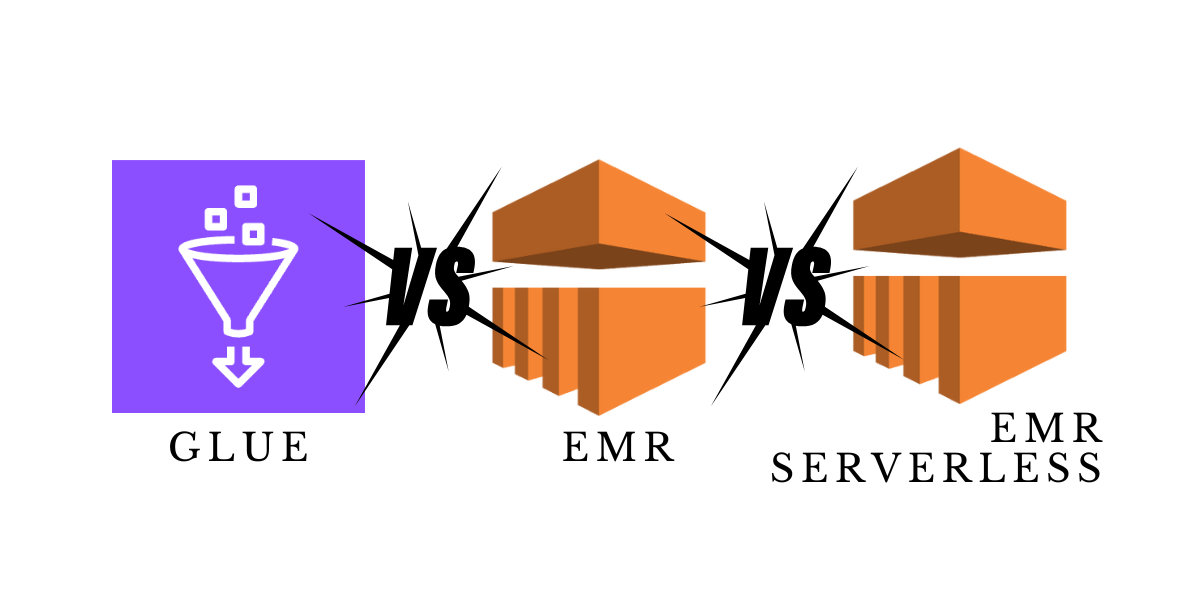Choosing the Right Tool for the Job - AWS Glue, EMR, and EMR Serverless Explained
Definition:
Glue
AWS Glue is a serverless data integration service .you can visually create, run, and monitor extract, transform, and load (ETL) pipelines to load data into your data lakes
EMR
AWS EMR is a managed cluster platform designed to streamline the execution of big data frameworks, such as Apache Hadoop and Apache Spark, on AWS. This facilitates the processing and analysis of large datasets.
EMR Serverless
AWS EMR Serverless is a deployment alternative for Amazon EMR that offers a serverless runtime environment. This simplifies the management of analytics applications utilizing contemporary open-source frameworks like Apache Spark and Apache Hive. With EMR Serverless, you are relieved of the tasks of configuring, optimizing, securing, or managing clusters for running applications with these frameworks.
Framework Supported:
Glue:
Apache Spark: AWS Glue internally uses Apache Spark for distributed data processing. Python (PySpark): You can write ETL scripts in Python using PySpark, which is the Python API for Spark.
EMR and EMR Serverless:
Apache Hadoop: A distributed computing framework for processing large datasets across clusters of computers.
Apache Spark: A fast and general-purpose cluster computing system for big data processing.
Apache HBase: A distributed NoSQL database for random, real-time read/write access to large datasets.
Apache Flink: A stream processing framework for real-time analytics and event-driven applications.
Apache Hudi: A data lake storage system for managing large-scale, incremental data processing.
Presto: A distributed SQL query engine for interactive analytic queries over big data.
Scripting Language:
Glue:
Python(pyspark) and Scala
EMR and EMR Serverless:
Python, Scala,JAVA,R, Hive, Pig, Ruby, Perl, PHP, C++
Pricing:
Glue:
Pay-per-use model: You only pay for the resources used by your Glue jobs. This includes:
Data Processing Units (DPUs): Virtual processing units that power your Glue jobs. Billing is per DPU-hour.
Crawlers: Services that discover and define your data schema. Billed per DPU-hour for the duration the crawler runs.
Other services: Additional charges might apply for features like data catalog storage and writing data to other AWS services (e.g., S3).
Estimated Cost: It’s difficult to provide an exact cost upfront as it depends on your specific usage. However, Glue jobs typically cost around $0.44 per DPU-hour.
Amazon EMR:
On-demand instances: You pay for the underlying compute resources (EC2 instances) used by your EMR clusters. The cost depends on the instance type, size, and running duration.
Spot Instances: An optional way to potentially save on EMR cluster costs by using spare EC2 capacity. However, Spot Instances can be interrupted if the underlying demand for those resources increases.
Software Licenses: Additional charges may apply for using certain software licenses within your EMR clusters (e.g., some Hadoop components).
Estimated Cost: EMR costs can vary significantly based on chosen instance types, cluster size, and running time. It’s generally more cost-effective for long-running or complex processing jobs compared to Glue.
Amazon EMR Serverless:
Pay-per-use model: You are billed based on the resources consumed by your serverless EMR applications.
This includes:
vCPU-seconds: Billed per second for the virtual CPU time used by your application.
Memory MB-seconds: Billed per second for the memory used by your application.
Storage GB-seconds: Billed per second for storage used by your application (only if exceeding the free 20 GB per worker).
Estimated Cost: EMR Serverless can be cost-effective for short-lived or unpredictable workloads due to its serverless nature and automatic scaling. However, for long-running jobs, EMR clusters with on-demand instances might be more economical. Here are some resources for further details on pricing:
AWS Glue Pricing: https://aws.amazon.com/glue/pricing/
Amazon EMR Pricing: https://aws.amazon.com/emr/pricing/
Amazon EMR Serverless Cost Estimator: https://aws.amazon.com/blogs/big-data/amazon-emr-serverless-cost-estimator/**
Conclusion:
Choosing the right service for cost-effectiveness depends on your specific needs:
Glue-For short and infrequent ETL jobs, AWS Glue can be cost-efficient due to its pay-per-use model.
EMR-For long-running or complex big data processing tasks, Amazon EMR with on-demand instances might be more cost-effective compared to Glue.
EMR Serverless-Amazon EMR Serverless is a good option for unpredictable or short-lived workloads with simpler processing needs.
It’s always recommended to estimate your resource usage and compare pricing models before choosing a service for your big data workloads on AWS.
If you enjoy the article, Please Subscribe.
